10.02.2020
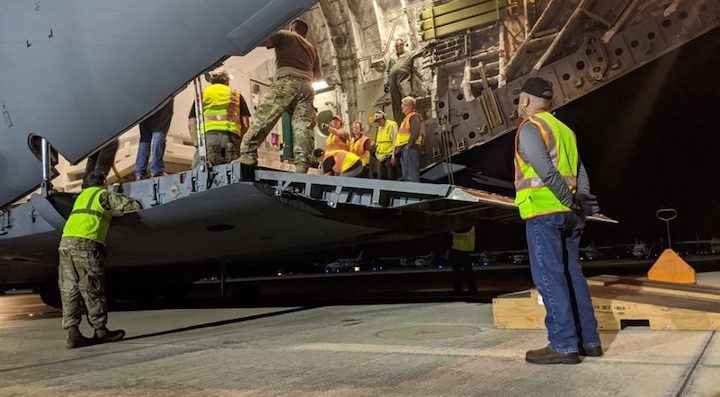
WASHINGTON — The third satellite of the GPS 3 constellation arrived Feb. 5 at Cape Canaveral Space Force Station, Florida, where it will undergo final testing and checkout before its scheduled launch in April aboard a SpaceX Falcon 9 rocket.
The GPS 3 satellite was flown from Lockheed Martin’s assembly line in Colorado aboard a U.S. Air Force C-17 cargo aircraft.
In a news release on Friday, the U.S. Space Force Space and Missile Systems Center said the next steps are to prepare the GPS 3 SV-3 for propellant loading and fairing encapsulation before it’s horizontally integrated with a Falcon 9 launch vehicle.
“The delivery of SV03 marks the start of our second GPS 3 launch campaign on a SpaceX Falcon 9 rocket and brings us another step closer in advancing the GPS constellation with more capable satellites,” said Col. Edward Byrne, chief of SMC production corps’ medium Earth orbit space systems division.
The April launch will be SpaceX’s second GPS 3 mission (the first one launched in December 2018) and its second launch awarded under the National Security Space Launch program. The company delivered a new Falcon 9 Block 5 booster for this mission.
In keeping with a tradition of nicknaming satellites after famous explorers, the GPS 3 SV03 was named Columbus after the Italian explorer Christopher Columbus.
Lockheed Martin is under contract to build up to 32 GPS 3 satellites.
In January, SV01, the first first satellite of the GPS 3 constellation (Vespucci) was declared active by the U.S. Space Force 2nd Space Operations Squadron at Schriever Air Force Base, in Colorado.
GPS 3 SV02 (Magellan) launched in August aboard a United Launch Alliance Delta 4, has completed on-orbit testing and is waiting to be integrated into the constellation of 31 GPS satellites currently in operation.
After the launch of SV03 in April, the next one (SV04) is projected for later this summer. SV05 through SV09 are in various stages of assembly and test at Lockheed Martin’s production line near Denver.
Quelle: SN
+++
Satellite Delivered for Space Force’s First GPS III
Launch
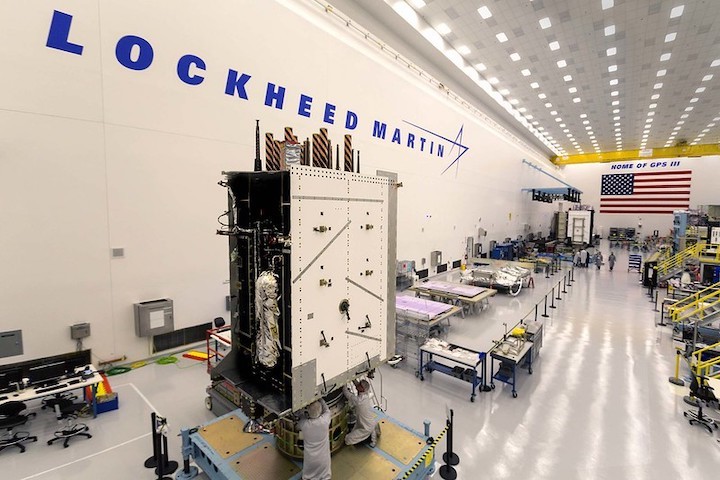
The Space Force has received its first GPS III satellite, with a launch slated for April.
The Lockheed Martin-built next-generation satellite, which was shipped to Cape Canaveral, Florida, on a C-17 from Buckley Air Force Base, Colorado, is the third GPS III to be delivered. The first launched in December 2018 and was set “healthy and active” by the 2nd Space Operations Squadron on Jan. 13, making it available for military and civilian GPS users. The second launched in August, has finished on-orbit testing, and is waiting its turn to be integrated into the constellation, Lockheed Martin said in a press release.
“We are excited to help the Space Force refresh the constellation to ensure U.S. and allied forces always have the best technology, and that the U.S. Global Positioning System remains the gold standard” for positioning, navigation, and timing services, Tonya Ladwig, Lockheed Martin program manager for GPS III, said in the release.
Lockheed is under contract to design and build 10 GPS III systems and up to 22 GPS III Follow-On systems. The fourth is set to launch this summer.
GPS III satellites are three times more accurate and have significantly better anti-jamming capabilities than previous satellites, officials say.
Quelle: Air Force Magazine
----
Update: 17.02.2020
.
Next GPS satellite lands in Florida for April launch
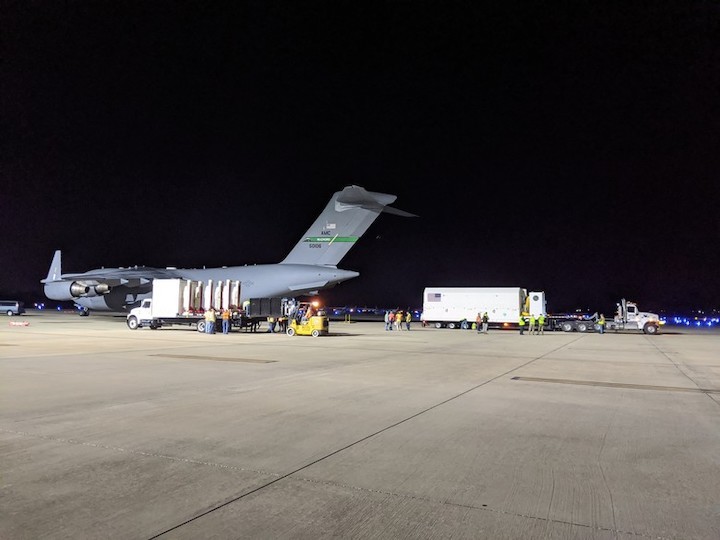
The U.S. Space Force’s third new-generation GPS 3-series navigation satellite has arrived in Florida for final processing and fueling ahead of a launch currently targeted for April 29 aboard a SpaceX Falcon 9 rocket.
The GPS 3 SV03 spacecraft landed Feb. 5 at Space Coast Regional Airport in Titusville, Florida, after a ride aboard a U.S. Air Force C-17 cargo plane from Buckley Air Force Base, Colorado, near the satellite’s Denver-area Lockheed Martin factory.
The navigation satellite was trucked to the nearby Astrotech payload processing facility, where Lockheed Martin teams will configure the craft for launch, fill it with maneuvering propellant, and encapsulate the satellite inside a SpaceX payload fairing before moving to a nearby SpaceX launch facility.
Teams there will mount the payload horizontally to a Falcon 9 rocket before rollout and launch.
Liftoff of the GPS SV03 spacecraft is currently scheduled for April 29 some time during a four-hour launch period opening at 7 a.m. EDT (1100 GMT). An exact launch time will be announced later.
The GPS SV03 satellite is the third in the newest series of GPS navigation spacecraft, following the launch of the GPS 3 SV01 satellite in December 2018 aboard a Falcon 9 rocket, and the deployment of the SV02 platform in August 2019 by a United Launch Alliance Delta 4 rocket.
Both missions were successful, and the satellites are operating normally in orbit roughly 12,550 miles (20,200 kilometers) above Earth.
The GPS SV03 satellite is named “Columbus” after Christopher Columbus, the Italian explorer who visited the Americas on four expeditions beginning in 1492. The SV01 and SV02 spacecraft were named Vespucci and Magellan.

“The arrival of the third GPS 3 satellite is another landmark for the program and is a testament to the professionalism, hard work and dedication of GPS team members from all parts of the country,” said Col. Edward Byrne, chief of Production Corps’ Medium Earth Orbit Space Systems Division at the Space Force’s Space and Missile Systems Center. “The delivery of SV03 marks the start of our second GPS 3 launch campaign on a SpaceX Falcon 9 rocket and brings us another step closer in advancing the GPS constellation with more capable satellites.”
The GPS network provides positioning and timing services worldwide for military and civilian users, beaming signals relied upon by airliners, ATMs, drivers and smart bombs, among numerous other users.
The Space Force says GPS SV03 will join 31 operational satellites in the GPS fleet providing non-stop positioning, navigation and timing services.
The GPS 3 satellites offer more accurate navigation signals and boast longer design lifetimes. The new GPS 3 satellites provide a new L1C civilian signal that is compatible with Europe’s Galileo navigation network.
Like the previous line of Boeing-built GPS 2F satellites, all GPS 3-series spacecraft broadcast a dedicated L5 signal geared to support air navigation. The GPS 3 satellites also continue beaming an encrypted military-grade navigation signal known as M-code.
Lockheed Martin is on contract with the Air Force to build up to 32 satellites, including 10 GPS 3 spacecraft and 22 upgraded GPS 3F satellites.
Quelle: SN
----
Update: 24.02.2020
.
SpaceX's next military launch cleared for historic rocket landing attempt
SpaceX officially has permission to perform a Falcon 9 booster recovery after its next launch for the US Air Force, now guaranteed to be the first time a rocket booster attempts to land during an operational launch for the US military.
Alongside their booster landing attempt confirmation, the USAF Space and Missile Systems Center (SMC) also posted the first official SpaceX video of a rocket acceptance test released in almost 2.5 years, a test it says was completed just days after the GPS satellite it’s scheduled to launch arrived in Florida. The very same Falcon 9 booster was shown off in unprecedented detail just last month and now SMC says that SpaceX fired up the rocket at its McGregor, Texas development facilities for a routine static fire on February 13th. The company is currently scheduled to launch its second USAF GPS III satellite – Space Vehicle 03 (SV03) – no earlier than 7am EDT (11:00 UTC), April 29th, a target set just days ago.
With the spacecraft in Florida and factory-fresh Falcon 9 booster successfully proofed, all that remains is for SpaceX to test and deliver the mission’s Falcon upper stage and payload fairing (if it hasn’t already). After the booster – believed to be B1060 – is inspected and its tanks are cleaned, it can also be packaged and transported by road the rest of the way to SpaceX’s Florida launch facilities, setting the company up for the critical mission and historic landing attempt.
While SpaceX has technically already landed Falcon 9 and Falcon Heavy boosters after its NROL-76 and STP-2 launches for the NRO and USAF, the company only officially began operational military launches once its Falcon 9 rocket was fully certified. STP-2, for example, was effectively high-stakes make-work designed to help the USAF fully certify SpaceX’s brand new Falcon Heavy rocket to launch expensive – verging on irreplaceable – military satellites.
Its first truly operational US military launch occurred in December 2018, when Falcon 9 booster B1054 was intentionally expended in support the USAF’s inaugural GPS III launch, successfully placing the first of 10 (or 32) planned upgraded navigation satellites into orbit. It’s believed that the USAF required such extreme safety margins (extra propellant and performance) that SpaceX couldn’t even attempt booster or fairing recovery. This made B1054 the first (and hopefully only) Falcon 9 Block 5 booster to launch without even the basic hardpoints needed to attach landing legs.
Effectively confirming that B1054’s demise was was a contrivance and by no means a technical necessity, the SMC announced on February 20th that SpaceX’s GPS III SV03 mission is officially “the first time a booster is planned to land on a drone ship during a NSS [National Security Space] launch.” Effectively identical to B1054 aside from the addition of grid fins and landing legs, this means that Falcon 9 booster B1060 will be able to attempt a landing aboard a SpaceX drone ship shortly after launch.
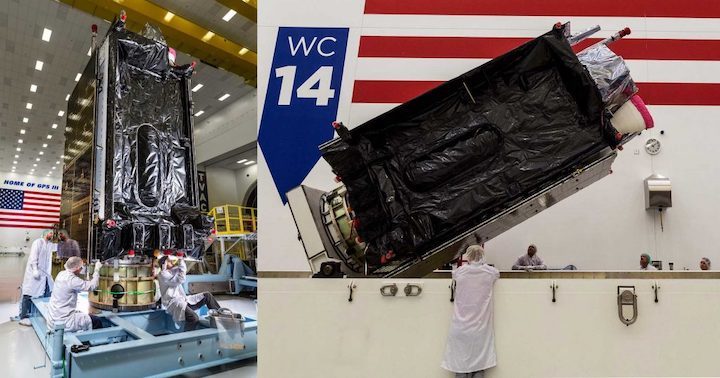
Just like GPS III SV01 satellite launched by SpaceX in December 2018 and the GPS III SV02 satellite launched United Launch Alliance (ULA) launched in August 2019, GPS III SV03 is a more than $500 million spacecraft designed to upgrade the US GPS navigation constellation. SpaceX has already won five (of five) competitively-awarded GPS III launch contracts thanks to its Falcon 9 rocket’s exceptionally competitive pricing, meaning that there is an excellent chance the company will win many more in the near future.
GPS III SV03 is one of 10 “Block IIIA” satellites to be launched between 2018 and 2026 and will be followed by another 22 “Block IIIF” satellites to be built by Lockheed Martin for ~$330M apiece. All 26 unassigned spacecraft will need launches of their own between now and the mid-2030s, worth anywhere from $1-2.5B to SpaceX if the company performs well on all five of its first contracts and continues to crush competitor ULA on launch costs.
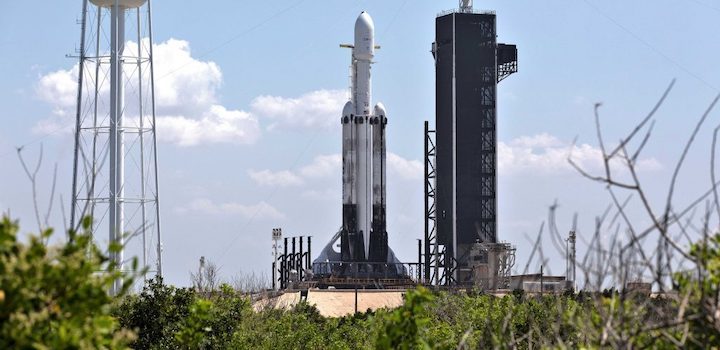
Falcon Heavy launched the USAF STP-2 mission with two flight-proven side boosters, launched barely 74 days after their first flights. Note the scorched landing legs and sooty exteriors. (NASA – Kim Shiflett)
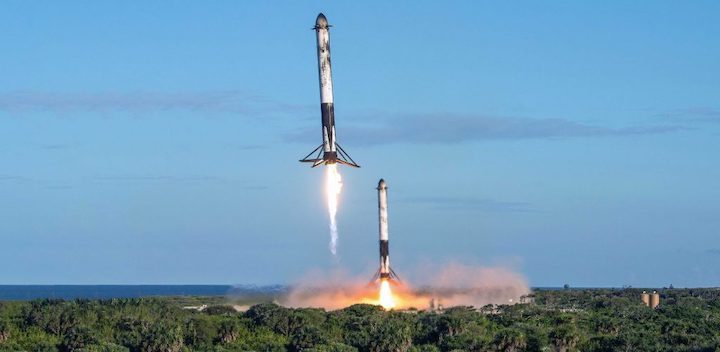
With the USAF already demonstrably interested in supporting Falcon booster reusability and now open to SpaceX recovering Falcon 9 boosters after moderately-challenging GPS III launches, it’s safe to say that SpaceX’s ultra-competitive pricing is here to stay.
Quelle: TESLARATI
----
Update: 9.04.2020
.
Pandemic pushes SpaceX GPS 3 launch to late June
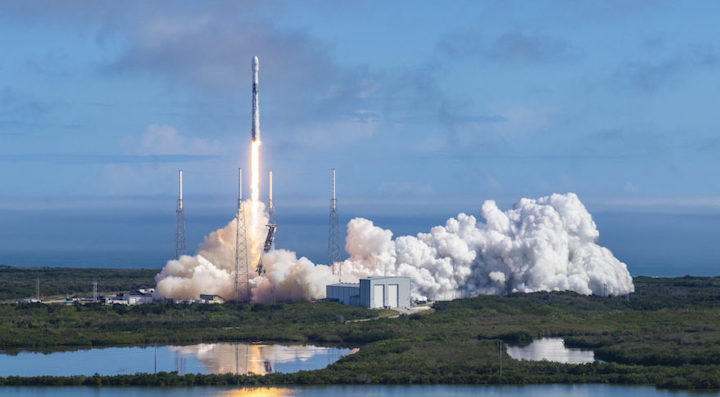
WASHINGTON — The U.S. Space Force’s Space and Missile Systems Center has decided to reschedule the launch of the third GPS 3 satellite from Cape Canaveral Air Force Station to minimize the potential of COVID-19 exposure to the launch crew and operators, a spokesperson said April 7.
The launch was scheduled for late April and is now projected for June 30 at the earliest.
The GPS 3 satellite made by Lockheed Martin will be launched on a SpaceX Falcon 9 rocket. This will be the second National Security Space Launch mission for the Falcon 9 rocket and the first NSSL mission where SpaceX will attempt to recover the booster.
The Space and Missile Systems Center decided that the current GPS constellation with 31 satellites in orbit is providing adequate services, so taking a pause in launches would not affect operations and allows the range to focus on the health of the workforce, SMC said.
The 45th Space Wing that operates the launch range at Cape Canaveral at Patrick Air Force Base, Florida, was able to carry out a national security launch on March 26 during the pandemic. On March 30, the wing commander Brig. Gen. Doug Schiess declared a public health emergency for Patrick Air Force Base and Cape Canaveral Air Force Station due to the increased number of positive cases in the local area.
SMC said it still plans to complete the next three GPS launches in 2020.
Quelle: SN
+++
SMC reschedules GPS III-3 launch
LOS ANGELES AIR FORCE BASE, Calif. --
The United States Space Force’s Space and Missile Systems Center (SMC) has decided to reschedule the launch of GPS III SV03 (GPS III-3) from Cape Canaveral Air Force Station to minimize the potential of COVID-19 exposure to the launch crew and early-orbit operators.
The current GPS constellation is healthy, allowing for a strategic pause to ensure the health and safety of our force without operational impact.
Originally scheduled for late April 2020, the launch is now projected for no-earlier than June 30, pending a re-evaluation in May.
“We do not make this decision lightly, however, given our GPS constellation remains strong, we have the opportunity to make a deliberate decision to maintain our mission assurance posture, without introducing additional health risk to personnel or mission risk to the launch,” said Lt. Gen. John F. Thompson, SMC commander and program executive officer for space.
GPS III-3 brings the third modernized GPS III satellite to the operational GPS mission, and the team remains ready to execute. GPS III will bring three times better accuracy and up to eight times improved anti-jamming capability than its predecessor.
The current constellation is healthy with 31 satellites on orbit, allowing the team to take this strategic pause without gaps in coverage or capability.
“The GPS system supports vital U.S. and allied operations worldwide, unabated. As the COVID-19 pandemic is a threat to national security, likewise, rescheduling the launch is in the interest of national security,” said Gen. Thompson. “We have to get it right the first time, and protecting our people is just as important as cost, schedule, and performance.”
SMC still plans to complete the next three GPS launches in 2020. The team is taking the necessary steps to protect the health of personnel to allow a swift return to the mission.
“Some of the steps include procedural and facility modifications at the GPS III Launch and Checkout Capability (LCC) operations center and reducing the onsite crew size to provide adequate physical distancing, per CDC guidelines,” said Col. Edward Byrne, chief of Medium Earth Orbit Space Systems Division. “Once these efforts are completed, and the crews have rehearsed and are deemed proficient and ready to execute under these modified conditions, we fully intend to return to our launch cadence for deploying GPS III satellites.”
A leader of GPS III acquisition, SMC’s Production Corps is the United States Space Force’s acquisition office for producing and delivering GPS satellites, ground systems and military user equipment. The Production Corps’ agile program management techniques, smart business approach and close teaming with Lockheed Martin Space are enabling the production and delivery of GPS III’s new civil and warfighting capabilities by 2023. GPS delivers the “gold standard” of space-based positioning, navigation, and timing services vital to U.S. and allied operations worldwide, and underpins critical financial, transportation, and agricultural infrastructure that over 4 billion users have come to depend on daily.
SMC’s Launch Enterprise, located at Los Angeles Air Force Base, California, is responsible for the acquisition and operation of launch vehicles, which includes mission assurance and launch safety. The Launch Enterprise is also responsible for leading the effort to certify new entrants to provide launch services for National Security payloads.
GPS III SV03 will be launched into operational orbit by a SpaceX Falcon 9 rocket. GPS III SV03 will be the second National Security Space Launch (NSSL) mission to be launched on a SpaceX Falcon 9 rocket and the first NSSL mission where a Launch Service Provider is recovering a booster.
The Space and Missile Systems Center is the U.S. Space Force's center of excellence for acquiring and developing military space systems. SMC’s portfolio includes space launch, global positioning, military space vehicle communications, defense meteorological space vehicles, range systems, space vehicle control networks, space-based infrared systems, and space situational awareness capabilities.
SMC continues to deliver vital capabilities to the warfighter and the world, despite the challenges of COVID-19. Recent examples include the successful launch of AEHF-6 on March 26, Operational Acceptance of GPS III SV02 by Space Operations Command on 27 Mar, and the inclusion of SV02 into the operational GPS constellation on April 1.
Quelle: United States Space Force
